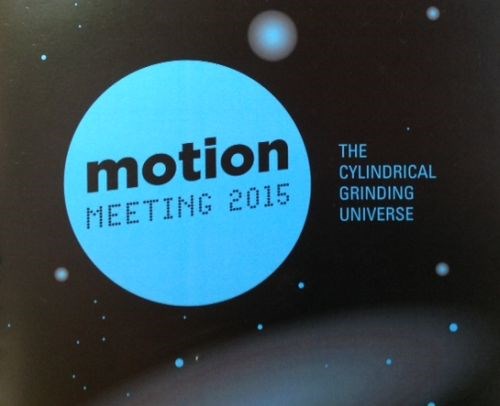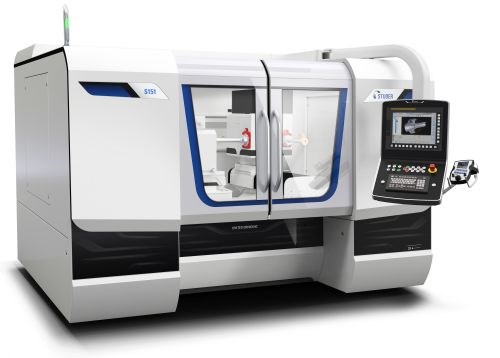Cylindrical Grinding Technology in Motion
United Grinding's annual Motion Meeting in Thun, Switzerland, highlights the group’s latest developments in cylindrical grinding. News from this year’s event includes the introduction of new models that broaden the range of ID and OD cylindrical grinding in the Studer line.

“The Cylindrical Grinding Universe” was the theme for United Grinding’s 2015 Motion Meeting in Switzerland. This theme was particularly appropriate because a key point was the expansion of ID grinding capability to provide universal coverage of the full range of workpiece sizes.
Every year, United Grinding hosts a gathering of its sales partners and trade press editors from around the world. The purpose of this annual ‘Motion Meeting” in Thun, Switzerland earlier this month, was to highlight the group's latest developments in grinding technology, especially in the area of cylindrical grinding, which includes the Studer, Schaudt and Mikrosa brands. United Grinding also used this occasion to deliver its prestigious Fritz Studer Award for innovative research in machine tool or grinding technology.
Topping the list of new products introduced at the event are the Studer S131 and S151 cylindrical grinding machines, which are built on the innovative S141 cylindrical grinding platform. The S141 platform is distinguished by ID and OD grinding capability enabled by a grinding spindle turret that accommodates as many as four grinding spindles. Both internal and external grinding operations can be completed in one setup to enhance accuracy and reduce non-cut times.
The S131 is smaller than the S141. It has a swing diameter over the table of 250 mm (9.8 inches) and a maximum grinding length of 175 mm (6.9 inches) for ID grinding and 125 mm (4.9 inches) for OD grinding. It accommodates workpieces as long as 300 mm (11.8 inches).

The S131 is a compact ID/OD grinder for smaller work pieces.
For reference, the S141 is available in models for machining workpieces with maximum lengths of 300, 700 or 1,300 mm (11.81, 27.56 or 51.18 inches) and IDs ranging to 250 mm (9.84 inches).
To complete the series, the S151 is larger than the S141. The new S151 features a swing diameter over the table of 550 mm (21.6 inches) and a maximum grinding of length of 400 mm (15.7 inches) for ID work and 150 mm (5.9 inches) for OD work. It accommodates workpieces with a maximum length of 700 mm (27.5 inches).

The S151 grinds workpieces as long as 700 mm (27.5 inches).
Studer’s line of ID/OD grinders now covers the range of shaft diameters and lengths with no gaps for both ID and OD capability for complete grinding in one clamping. In addition, all of the machines share the same ergonomics and clean, streamlined styling of the enclosure and pendant-mounted control unit.
Another recent product worthy of mention is the CrankGrind, a crankshaft grinding machine from Schaudt. Cosmetically, this grinder sports that “new look” that represents the unified corporate identity within the Cylindrical Grinding Group as well as the company-wide emphasis on functionality and ergonomics. More important is its capability. The CrankGrind is designed to do rough- and finish-grinding of both main and pin bearings on automotive crankshafts, all in one setup on one machine.

The Schaudt CrankGrind is designed to be a “superproductive” grinder for the complete grinding of automotive crankshafts.
The Motion Meeting also affirmed Studer’s leadership in energy efficiency, which is a concern among all machine tool builders and end users. Studer’s multi-prong approach may be a model for comprehensive energy management in industrial equipment. For detailed commentary, click here.
A further highlight of the meeting was the presentation of the 2014 Fritz Studer Award to Dr. Eduardo Weingärtner from the Swiss Federal Institute of Technology Zürich. Dr. Weingärtner’s work pioneered the application of the wire EDM process for on-machine dressing of metal bonded grinding wheels. This research was instrumental in the introduction of the Studer WireDress system detailed here.
Finally, as a bonus for visiting trade press editors, a tour of United Grinding's Mägerle brand was arranged in Fehraltdorf prior to the conclave in Thun. Mägerle, part of the company’s surface and profile grinding group, specializes in large, multi-axis grinding machines. These highly engineered systems are custom-built from flexible modules to combine unique applications with proven design concepts. Although Mägerle grinders represent some of the most demanding and advanced applications in grinding, the company continues to rely on a solid foundation of traditional skills such as hand scraping of ways for mechanical accuracy. In fact, the company's apprenticeship program aggressively courts young talent to replenish its highly skilled workforce, and is a model for sustaining the thoroughly Swiss tradition of precision and meticulous craftsmanship.

Although Magerle does not produce “standard” models of grinders, it does offer distinct product ranges, including the MFP line of multi-axis surface and profile grinders. The MFP 50 shown here is part of a grinding cell for a jet engine manufacturer. The new styling of the MFP grinders reflects the corporate redesign.
Related Content
Choosing a Five-Axis Machine Tool With Automation in Mind
While much focus is placed on the machinery that moves parts, the features most important for automating five-axis machining are arguably found in the machine tool itself.
Read MoreHow to Start a Swiss Machining Department From Scratch
When Shamrock Precision needed to cut production time of its bread-and-butter parts in half, it turned to a new type of machine tool and a new CAM system. Here’s how the company succeeded, despite the newness of it all.
Read MoreA New Milling 101: Milling Forces and Formulas
The forces involved in the milling process can be quantified, thus allowing mathematical tools to predict and control these forces. Formulas for calculating these forces accurately make it possible to optimize the quality of milling operations.
Read More10 Things to Know About Creep-Feed Grinding
Because of the high material removal rate creep-feed grinding can deliver in challenging materials, grinding might not be just the last step in the process—it might be the process.
Read MoreRead Next
The Cut Scene: The Finer Details of Large-Format Machining
Small details and features can have an outsized impact on large parts, such as Barbco’s collapsible utility drill head.
Read More3 Mistakes That Cause CNC Programs to Fail
Despite enhancements to manufacturing technology, there are still issues today that can cause programs to fail. These failures can cause lost time, scrapped parts, damaged machines and even injured operators.
Read More













.png;maxWidth=300;quality=90)


.png;maxWidth=300;quality=90)









